Sample Projects 2.0
[IN PROCESS]
This article gives an overview of the Sample Projects included with Loopy Pro 2.0.
Main Projects
Demo
Introductory demo project (by Dub Fx). A fun phase-locked looper project from Dub FX.
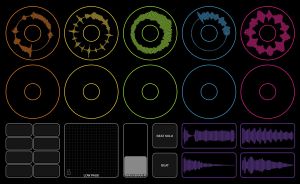
Key features: XYZ Pad controlling Low-Pass filter. Clip slicer. Five fun loops with which to get started having fun.
Simple Scenes Example 1
A simple example of scenes using Play Groups. This example uses mutually-exclusive, all loops play together play groups to create scenes. A scene can be triggered by pressing its button or by riggering any loop in a scene. Features two independent loops that can play at any time without interfering with the play groups.
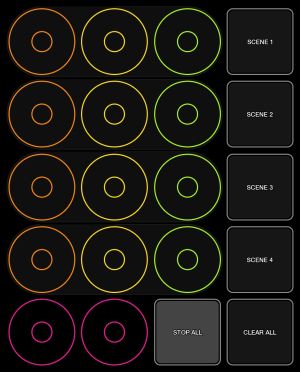
Key features: all loops play together play group option, mutually exclusive play groups.
See the project's tutorial widgets for more details.
Simple Scenes Example 2
A simple example of scenes using Solo actions. This scene looks identical to Simple Scenes Example 1 but it behaves differently. Unlike Example 1, the groups are set up so that the clips play independently rather than play/stop together. The groups are also not mutually exclusive as they are in Example 1.
You can trigger a scene with its button, but the clips can play independently. So, you can turn clips off in a scene without stopping the scene, and you can trigger clips from other scenes. If you have turned off any of a scene's clips while the scene was playing, retriggering the scene will trigger just the clips that were playing.
See the project's tutorial widgets for more details.
5x5 Scenes
A 5x5 grid with scene buttons and a row of independent clips. Each scene row is a mutually exclusive play group that is set to let the clips play independently. You can turn clips on and off in a scene. Retriggering a scene plays just the clips that were last playing in the scene. The purple clips at the bottom are unaffected by scene playback. The Scene buttons use the Solo/Un-Solo action targeted that the row's play group.
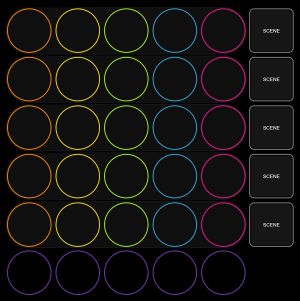
LP 707
Inkie's RC-505-style template with extended functionality. This is a five-track looper reminiscent of the RC-505 with integrated effects (via 3rd Party AUv3). The project has an on-screen tour. Inkie has created a video tutorial that explains it all.
The template makes use of some 3rd-party plugins. You can substitute your own effects if you wish.
- BLEASS Sample Wiz 2
- Sugar Bytes' Turnado
- Caelum Audio's Flux Pro
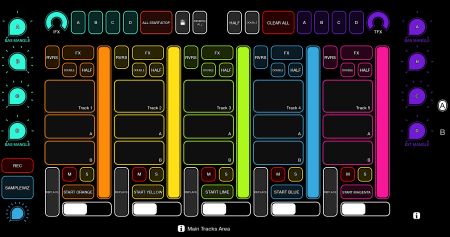
Verse-Chorus Looper
A 4-pedal Verse-Chorus looper, inspired by the VL3. This looper features mutually exclusive verse and chorus loops and an independent groove clip. This project makes use of follow actions (more on that below). This is a good starter project for building serial loopers. The project also features a fun trick for using a two-pedal combination to clear the project.
Key features: When a clip is playing, queuing playback or record of the other clip lets the current clip complete its cycle. If a groove clip has been recorded, verse and chorus recording is quantized to multiples of the groove length. Retrospective recording button.
Designed as a pedal looper with 4-switch operation. Pedal 1 - verse. Pedal 2 - chorus. Pedal 3 - groove. Pedal 4 - mode switch.
In record mode:
- Pedal tap toggles between play and overdub when a clip is playing. Plays the clip if it is stopped.
- Double-tap stops the clip at the end of its cycle)
- Hold clears the clip
In play mode:
- Pedal tap toggles between play and stop. Plays the clip if it is stopped.
- Double-tap immediate overdub switch.
- Hold clears the clip
The project is pre-configured with the MIDI CCs used by the iRig Blueboard or the M-Vave Chocolate in Manufacturer Control mode: MIDI CC's 20-23 for buttons 1 through 4.
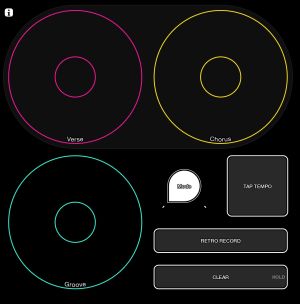
How it works. The clips make use of follow actions that change the master cycle length and realign the clock when a part starts playing even if the parts are different lengths.
To add more mutually exclusive clips, use the following steps so that new clips will have the follow actions needed for well-behaved serial looping.
- Copy the verse clip
- Paste the copied clip
- Add the clip to play group 1 (the only play group)
MIDI Showcase
A showcase of Loopy Pro 2.0's new MIDI capabilities. This project introduces some of Loopy Pro 2.0's new MIDI system.
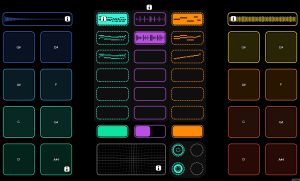
Key features:
- MIDI Looping
- Using MIDI to polyphonically play audio one-shots and loops
- Playing/recording MIDI from widgets with Send MIDI Actions
- Using MIDI loops to record and play back effect parameter automation
- Loopy's new onscreen keyboard widget
Simple 4 Track Looper
Adam Searan - A Chewie Monsta-inspired simple 4-track looper. An easy-to-use 4-track looper with phase-locked loops.
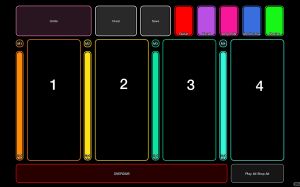
Tutorials
These projects explain demonstrate key Loopy Pro concepts. A little bit of time spent with these lessons will increase your productivity immensely.
Master Clock Length
The Master Clock Length is often used to start and stop recording. Explore this project to experiment with master clock.
See also: The Simple Looper tutorial shows the master cycle in action and shows how you might use it in real life.
Phase-Locked vs Free Loops
A demonstration of Phase Locked and Free clips. This is one of the key concepts in Loop Pro. Phase-locked loops have an always moving playhead even when the loop isn't playing, making it easy to drop in and out of loops while staying in sync. Free loops always start from the beginning when you start them playing -- perfect when working with loops and song sections of different lengths.
See also: Phase-Lock and Free Loops
Record Count-in and Out
Record count-in and count-out settings determine the length of clips and when recording starts. Loopy is flexible in how you can set it up. Recording can be tied to the master cycle or use a fixed custom length. Clips can automatically record a set length or record until you trigger the stop.
Other key features: The project makes use of the new Assign Settings action that lets you change the settings used by a clip, a color or all clips.
Simple MIDI Example - Loopy Pro as polyphonic sampler
This project demonstrates how Loopy Pro can be a polyphonic, MPE-capable sampler by targeting clips as MIDI targets. In this project, an audio clip is set as a destination of a MIDI color in the mixer. Sending MIDI to the color or playing a MIDI clip plays the audio clip polyphonically.
Simple MIDI Example 2
A simple example of a MIDI clip driving an AUv3 instrument.
MIDI Clip Automation Example
This project has an XY-Pad set up to control the cutoff and Q parameters of a low-pass filter and send MIDI messages that can be recorded and played back.
CircleSongs Tutorial
Jonas Viatte - A vocal live-looping tutorial